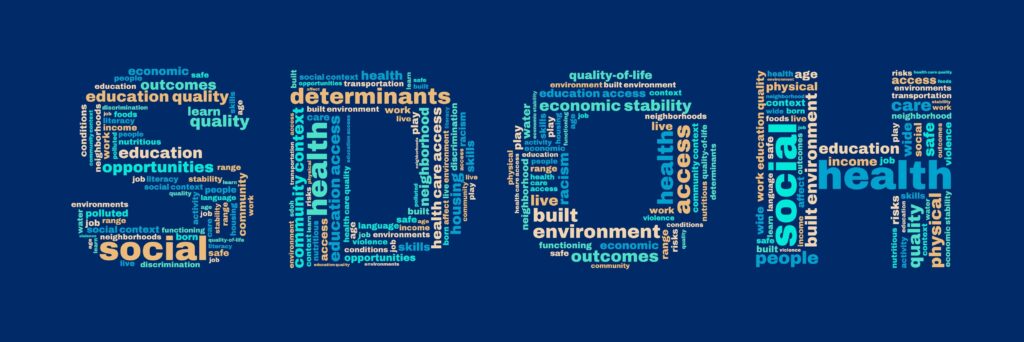How EHRs can bridge the digital gap that impedes health equity
Records systems and widely implemented standards can expand the capabilities of the nation’s health system to address social determinants of health.

Despite a role that is largely undefined – due, in large part, to variances in the practice of addressing social risk and delivering equitable care – the potential for electronic health record systems to address social determinants of health and advance health equity is significant.
Technology, when designed thoughtfully and implemented carefully, could standardize and make routine the collection of information, support the prompt exchange of data for workflow coordination and provide opportunities for retrospective analysis through the collection and visualization of large data sets.
The current reality, however, is more complicated.
Significant potential
EHR technology, in the same way it supports a standardized collection of clinical data such as problems, allergies and medications, can similarly be used to prompt users in the workflow to proactively collect demographic and determinant data.
Accurate and consistent collection of this data, by end-users or, more appropriately, by patients and families themselves, lays the groundwork for everything that comes after. The EHR provides the ability to insert consistent scripting and standardize data representation into workflow, and it could even enforce organizational policies on when and how this information is collected.
When data is collected accurately and, more importantly, consistently, the data can then be used to uncover latent biases or inequities of care. EHR dashboards, already widely used by organizations today to track the quality-of-care delivery (maternal mortality, hospital-acquired infections, readmission rates and the like), could be additionally stratified along patient demographics as well as determinant lines to highlight emergent disparities.
Recognizing patients with social risk factors is an important first step, but addressing those risks is the ultimate goal. Standards already exist today for electronic closed-loop referrals between healthcare delivery organizations, saving clinicians time and cutting down on manual data exchange processes. The same standards could be used to promptly refer patients with identified social risks to the community-based organizations (CBOs) that are best positioned to address them.
Barriers to progress
Optimal collection and use of demographic and SDOH data in EHRs face several challenges, including patient privacy concerns and the need for standardized data collection methods and standardized data representation.
For example, while EHRs are already capable of capturing a wide array of SDOH as well as race, ethnicity and language, this information is often left unpopulated because of inadequately trained staff or patients who are reluctant to share.
Further, while programs such as HL7’s Gravity Project are making progress, there is still much work to be done toward establishing standards-based SDOH information exchange. A standards-based representation of SDOH would not only help provide a more complete picture to clinicians at the point of care, but it also could be used to create a more complete picture of a community or region. Debate continues around exactly what SDOH should be captured and how this information can or should be used.
Another barrier lies with the technological capabilities of the community-based organizations that provide many of the services needed to address patients’ SDOH issues. While some provider organizations have established in-house programs to manage high-risk patients, their ability to leverage their EHRs and other existing technology to identify, enroll and monitor patients and program outcomes is something many of these organizations and social services programs do not share. For these organizations, sophisticated technology that enables the secure exchange of patient data with referring providers and metrics tracking is simply out of financial reach.
A multi-faceted solution
Eliminating the barriers that impede the role EHRs can and should play in advancing SDOH and health equity requires support from both the public and private sectors, starting with funding community organizations so they are able to implement interoperable technology to enable the sharing of SDOH data with referring providers and other agencies.
Funding through value-based social care reimbursement models for providers, states and health plans and waivers to support innovation and best practices would go a long way toward addressing the challenges limiting use of SDOH data across the healthcare ecosystem.
Focusing on interoperability, such as the real-time exchange of social and insurance data, clarifications regarding HIPAA requirements specific to social care referrals, and other regulations that impede social care assistance are also crucial.
Finally, one of the most impactful actions would come at the federal level – extending existing quality programs to incentivize consistent and complete data collection and then using that data to examine if disparities exist in current quality programs. Taking quality measures that are already being reported and stratifying them by race and ethnicity would further the understanding of the extent to which the healthcare system is delivering care and producing quality outcomes in an equitable way.
Realizing the potential
Despite existing challenges, the integration of accurate demographic and social determinants into EHRs has the potential to greatly improve health outcomes and reduce disparities in healthcare.
As the healthcare industry continues to adopt and integrate EHRs into clinical practice, it is important to prioritize their role in the collection and use of demographic and SDOH data to understand health equity and improve the overall health of all individuals.
Janet Campbell (Epic) is chair of the EHR Association’s Social Determinants of Health-Health Equity Task Force.